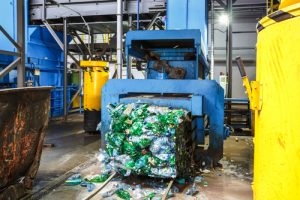 More than just being a pivotal year for recycling, I hope 2018 is a pivotal year for humankind. Our survival depends on us protecting “the commons” (our shared land, forests, oceans, air and other natural elements). However, we as a society continue to allow financial reasons to get in the way of fully protecting our most essential resources.
More than just being a pivotal year for recycling, I hope 2018 is a pivotal year for humankind. Our survival depends on us protecting “the commons” (our shared land, forests, oceans, air and other natural elements). However, we as a society continue to allow financial reasons to get in the way of fully protecting our most essential resources.
This disheartening reality becomes clear when we look through the prism of recycling.
Many recycling entities – particularly those in the plastics recycling segment – are facing severe financial challenges right now despite the environmental benefits that come when recovered materials are used to make new products.
Why is this happening? In short, the market for recycled materials is broken. We have equated collection with recycling when in reality that is just the first of many steps to ensure complete reabsorption of resources.
The China factor
While many of our recyclables have been “out of sight, out of mind” with the seemingly endless demand from China over the last 20-plus years, China’s demand for feedstock has effectively stunted the investments necessary for a healthy recycling ecosystem in the United States. But it’s not China’s fault; manufacturers in that country needed raw material. Now the Chinese are working to reabsorb their own scrap and reduce leakage into our oceans. Plus, there is plenty of low cost virgin resin on the market due the “shale gas revolution.” Although they may still want processed recycled plastic, Chinese stakeholders don’t need our scrap enough anymore to justify handling the world’s waste.
Before virgin resin prices dropped due to greater access to natural gas, we saw some investments made in secondary processing. They turned out to be a saving grace during the first restrictions on the import of scrap into China back in 2013. The National Sword was not sprung upon us. As far back as 2004, groups like the Northern California Recycling Association warned about dependence on China in their video, “Point of Return.”
In late 2017, my company, MORE Recycling, released the “End Market Demand for Recycled Plastic” study which documented insufficient domestic demand for polyethylene post-consumer resin (PCR): In 2015, converters had the capacity to process only 76 percent of the PE PCR acquired for recycling in the U.S.
So now we have less demand from China and less end market demand domestically with low virgin prices. It’s hard for companies to justify paying as much or more for PCR – even though life-cycle studies indicate that PCR has a lower carbon footprint than virgin resin and should, therefore, enjoy preferential purchasing in a time when curbing carbon emissions is critical.
The “End Market Demand Study” also found that the most significant barrier to converters’ use of PCR is insufficient supply of material that matches their specifications (and price point). While there are clear examples of high performing PCR, especially with mature recycling commodities like HDPE or PET bottles, U.S. businesses need both more supply of high quality PCR (all resins) and greater demand for products with PCR content. Both are necessary to attract investment in reclamation capacity. So, on the one hand, we have material that desperately needs a destination. And on the other, we have potential buyers that say many of the recyclables flowing through the industry pipeline are not up to snuff. It is this tension that must be addressed.
While some of the giants of the industry have made major strides in reducing processing costs and improving quality to compete with virgin, not all reclaimers have been able to make the investments necessary to specialize or vertically integrate (i.e., reclaim scrap and process into a new end use product) to ensure their survival in a down market.
Market challenges are being felt at the community level as folks search for new markets to replace the export market for low quality or mixed material bales. The drumbeat for bans on lightweight materials such as plastic bags and foam will likely get louder, especially when the cost to process lightweight or small items exceeds their value in the market.
Exploring tradeoffs
But if we ban the light material and simply replace those items with heavier materials, we directly increase greenhouse gas emissions. The transportation sector dwarfs plastics production in terms of fossil resource consumption. Thus if we want to protect our oceans from other dangers (such as acidification and marine debris), we need to embrace responsible material choices – we should strive to use the lightest material that protects products that carry embodied energy from extraction through production.
A quarter of greenhouse gas emissions come from food production. More than 70 percent of our water consumption is used to grow crops, yet we waste more than a one-third of food produced. When it comes to food packaging, plastics extend shelf life, thus reducing waste, and are the lightest weight option, which minimizes the environmental impacts of transportation.
While banning materials may not be the best option, we cannot continue to litter our world with plastic. We have to embrace responsible handling, starting with using less, reusing more, getting our chosen material into the appropriate bin, and buying products that contain recycled content. We must find value in PCR so that material can be reabsorbed into the economy. Otherwise, we fall short in truly achieving sustainable materials management.
Tangible steps to take now
My advice for what we can do today is to first provide clear messaging about keeping plastic film out the curbside stream. Ongoing, consistent, and clear messaging to keep film out of the curbside stream has been shown to boost the quality of recovered rigid plastics as well as the quality of fiber, which continues to make up most of the weight in the recycling stream.
Sustained educational campaigns that encourage residents to make use of return-to-retail programs do work. People respond by putting less film in their curbside bin. They return more types of film in addition to bags, and they are more likely to remember their reusable bags when shopping.
As far as how to handle other portions of the recycling stream, there are markets for segregated PET bottles, HDPE bottles, rigid PP, and even PS and flexible PE (if it’s clean and dry). The key word is “segregated.” What is a community to do if they lack the capacity to sort plastics into discrete resins? Who will pay for the investment for additional sorting capacity? There may be a materials recovery facility (MRF) or secondary MRF, like Titus, that can further sort mixed bales. Also, how far is too far to ship mixed materials? We need to start asking some hard questions.
The additional cost to sort will need to be covered by either the public sector or producers. We can’t expect MRFs to absorb all of the cost.
Funding the system
Admittedly, the trillion-dollar question is this: How do we fund a system when we haven’t yet recognized the inherent environmental value in PCR?
We should draw from the institutional knowledge of market development programs of past and present, a point recently articulated by Betsy Dorn and Susan Bush of RSE USA. Recycling market development programs are currently at work in states including California, Minnesota, North Carolina, Pennsylvania and South Carolina. How can we as an industry help those initiatives grow stronger and duplicate them elsewhere?
If we fail to reinstitute market development programs and implement the policies necessary to stimulate value in PCR scrap, plastic will undoubtedly become waste or marine debris. We now know this probability is greater with scrap shipped overseas based on the Ocean Conservancy’s “Stemming the Tide” report.
It may take time to figure out how to fund the system so in the short term, considering what MORE Recycling illustrates in the “Data Sort” section of the current print edition of Plastics Recycling Update (see chart below). By simply upping recycled content in one application – trash bags – end market demand could increase. We extrapolate from the current California law requiring 10 percent PCR in trash bags to determine the effects that could be seen if similar mandates were put in place nationwide.
Bringing it together holistically
An ultimate task is for stakeholders to find a meaningful way in which recycling becomes a primary tool in helping us address climate change and other monumental environmental threats that are increasingly being prioritized by governments, citizens and companies across the globe.
Returning to the example of increasing PCR content in trash bags, we find that replacing virgin plastic with 30 percent PCR would create a reduction in greenhouse gas emissions equivalent to removing 173,000 cars from the road for a full year. This approach fits in neatly with the overarching corporate sustainability goals that are already heralded by many brands, retailers and manufacturers.
We as U.S. citizens can either brace for further erosion of our recycling ecosystem or we can start addressing the fundamental economics of recycling. Let’s create jobs by handling our own material more responsibly.
To be clear, the ideas and steps outlined above all bring challenges when it comes to achieving stakeholder buy-in and ultimate implementation. But it’s up to our industry and others to find ways to tackle the difficulties that are causing the world to continue externalizing environmental costs.
At MORE Recycling, we’re helping out through information and organization. Look out soon for new resources as we strive to highlight leaders in the industry through a recycled content products directory and stimulating a #buyrecycled trend. We also have plans to report on aggregate greenhouse gas savings from demand champions and to produce tools to help communities engage residents and navigate tough decisions.
 Nina Bellucci Butler is the CEO of MORE Recycling, a research and technology firm with a mission to provide tools and services (including PlasticsMarkets.org) to accelerate the transition to a society that manages resources sustainably. Butler has worked to help overcome barriers in plastic recycling for more than 17 years. She can be contacted at [email protected].
Nina Bellucci Butler is the CEO of MORE Recycling, a research and technology firm with a mission to provide tools and services (including PlasticsMarkets.org) to accelerate the transition to a society that manages resources sustainably. Butler has worked to help overcome barriers in plastic recycling for more than 17 years. She can be contacted at [email protected].
MORE would like to acknowledge the American Chemistry Council, the Association of Plastic Recyclers and the Sustainable Packaging Coalition for funding the “End Market Demand for Recycling Plastics” study.
The views and opinions expressed are those of the author and do not imply endorsement by Resource Recycling, Inc. If you have a subject you wish to cover in an op-ed, please send a short proposal to [email protected] for consideration.
Top photo credit: hiv360/Shutterstock


